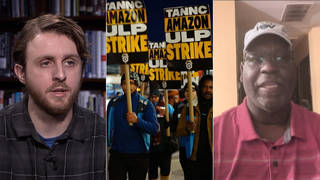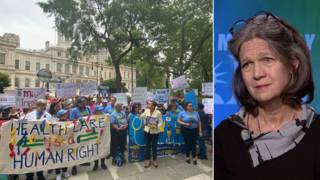
Related
After a leaked Supreme Court draft opinion revealed the intention to overturn Roe v. Wade, abortion has increasingly become a state issue, with conservative states criminalizing the procedure. Oklahoma approved a bill on Thursday that outlaws almost all abortions beginning at fertilization. The measure is modeled after a Texas ban that encourages private citizens to sue abortion providers and people who assist in abortions. The reproductive justice movement now faces not only these intense legal hurdles but also severe underfunding and an overreliance on billionaire-backed foundations that will not be sustainable for very long, warns Amy Littlefield, abortion access correspondent for The Nation.
Transcript
AMY GOODMAN: This is Democracy Now!, democracynow.org, The War and Peace Report. I’m Amy Goodman.
Oklahoma lawmakers have passed a bill that bans nearly all abortions starting at fertilization. The measure now heads to Republican Governor Kevin Stitt, who’s promised to sign what will become the nation’s strictest anti-abortion law. The legislation allows anyone to sue doctors who perform abortions or anyone who “aids or abets” an abortion — modeled on Texas’s anti-abortion law that took effect in September. The vote in Oklahoma comes just weeks after the publication of a leaked draft opinion showed the Supreme Court is preparing to overturn Roe v. Wade.
To look at the Oklahoma bill and the broader fight for reproductive rights, we’re joined by Amy Littlefield, the abortion access correspondent for The Nation. She has the new cover story, headlined “The Fight for Abortion After Roe Falls.”
Amy, it’s great to have you back, under very difficult circumstances, to say the least. First, comment on what this law is in Oklahoma, and then we’ll go broader.
AMY LITTLEFIELD: Great to be back with you, Amy, even under these really chilling circumstances. So, as you mentioned, Oklahoma’s Legislature has passed a total abortion ban. The only exceptions are to save the life of the pregnant person or cases of rape or incest that have to be reported to law enforcement. Right? And so, these are very, very narrow exceptions, that are subject to the interpretation of medical providers who are going to be terrified of violating this law.
And as you point out, this law begins at fertilization, which — you know, basic science lesson here for Oklahoma lawmakers: Fertilization is actually before pregnancy begins. Right? The fertilized egg, when it implants in the uterus, that’s when pregnancy starts, OK? Fertilization at the moment of the sperm and egg coming together is something that we can’t — we don’t actually know when that happens inside a person’s body, right? So, to recap sort of how we got here and where we are right now —
AMY GOODMAN: And by the way, it may not be inside a person’s body, right? When we’re talking about —
AMY LITTLEFIELD: True. This is true.
AMY GOODMAN: — people who are using IVF, what that means? If a lab assistant drops a test tube, will they be charged with murder?
AMY LITTLEFIELD: I mean, I think these are all really important questions, Amy, that it’s possible lawmakers have not considered in this sort of race to try to become the state with the harshest abortion ban in the country. You know, I think there’s a lot of questions that are being raised now, after this law has passed through the Legislature. Another major question is: Well, how does this law interact with all of the other abortion bans and attempts to restrict abortion that Oklahoma has passed, including a law that would take effect when the Supreme Court decision comes down overturning Roe v. Wade, you know, a criminal abortion ban?
So, to sort of recap how we got here — right, Amy? — I mean, I want to remind listeners that for nine months Texas has been living under a six-week abortion ban, that doesn’t quite go as far as Oklahoma, right? It allows abortions up to about six weeks of pregnancy. But we’ve already seen over the past nine months the huge cascading effect of just one state having not even a total ban in place, which is appointment times stretching on for up to four weeks at clinics in the region, patients having to flock to surrounding states, an untold number of people not getting the care they need. And we know that in the beginning with the Texas ban, about half of those patients were going to Oklahoma to get the abortion care that they could no longer get in Texas.
Well, then — and I don’t know how many of your listeners actually know this, because with the news from the Supreme Court, it’s sort of been lost, but two weeks ago, about two weeks ago, Oklahoma passed its own six-week ban, right? So both Texas and Oklahoma have been living under six-week abortion bans where the enforcement mechanism is this private civil enforcement mechanism, where private citizens can sue — you know, these private bounty hunters can sue anyone who aids or abets an abortion, and that’s the way these laws get around the courts and the way that these laws are enforced. And Oklahoma’s total ban has this same citizen enforcement mechanism, right?
AMY GOODMAN: Now, wait. Explain. So, if you’re a taxi driver —
AMY LITTLEFIELD: Right.
AMY GOODMAN: — who brings a pregnant person to a clinic —
AMY LITTLEFIELD: Right.
AMY GOODMAN: — you could be charged with aiding and abetting, if you’re sued by a person in New York who hears about this.
AMY LITTLEFIELD: Right. I mean, it’s really sweeping, you know, the idea of someone who aids or abets an abortion, especially when you consider that the anti-abortion movement has worked so hard over the years to make it almost impossible, especially for low-income people, to get an abortion without a lot of help, right? And so, it’s clear that the intended target, beyond abortion providers — right? — the intended targets of these laws are groups like grassroots abortion funds that help people pay for their abortions. And we’ve already seen attempts to criminalize these groups and to try to get a hold of their donor lists in Texas, by the same people who are behind these private enforcement laws. And that’s because, you know, they want to make people afraid to even donate to an abortion fund. I mean, what I’ve been told, in talking with these groups, is that this effort has backfired, and in fact what they’ve seen is an uptick in rage donations.
But, you know, I think — and it’s interesting. You know, a lot of people might look at these private enforcement laws and say, “Well, after the Supreme Court overturns Roe v. Wade, as we now know they’re going to do, we’re not going to need these private civil enforcement laws anymore,” right? Because states can just ban abortion, and prosecutors can enforce criminal laws, right? That’s what we’ve long expected to see. But I talked to the architect of the private civil enforcement mechanism, and he told me he doesn’t think that’s the case. He thinks the private civil enforcement mechanism is actually going to be really important after Roe, because what happens if you start to see shifts in the makeup of some of these states and you have elected state officials or prosecutors who don’t want to charge people criminally? Well, then you’ve got to have this situation where you can have, you know, a private resident enforce the abortion restriction — enforce a private enforcement mechanism, if the state officials and prosecutors aren’t willing to do so. So, I think we’re not going to see these private civil enforcement bounty hunter laws go away after the Dobbs decision.
AMY GOODMAN: So, I want to stick with this idea of going after donors to funds. Tell us who — you’ve got the little donors, and you’ve got the big ones. Tell us who Vlad is.
AMY LITTLEFIELD: Right, right. So, I mean, when you look at sort of the reproductive healthcare nonprofit world — right? — first of all, we have to look at, structurally, the fact that the anti-abortion movement over time has systematically tried to cut off every form of public funding to abortion care that they can. And so, enormous amounts of money has to be raised and spent every year just paying for people’s abortions, because in a majority of states Medicaid recipients don’t have access to that care under their insurance coverage, right? And so, huge amounts of money has to be raised and spent by the — and a huge amount of the most dynamic, energetic people in the movement are working on issues like: How do we pay for people’s abortions? How do we get them onto airplanes or into buses or get them to the care they need? It’s this massive logistics operation that requires a lot of money. And then you have all of the organizing work that’s going on on top of that, right?
And so, Vlad is this cheeky name that some people in the reproductive healthcare world use for the “large anonymous donor.” And the large anonymous donor is the code —
AMY GOODMAN: “Very large anonymous donor”?
AMY LITTLEFIELD: Very large. Vlad is “very large anonymous donor.” And, in fact, he is very large. And so, this is sort of the code word for Warren Buffett of Berkshire Hathaway fame, the 91-year-old business magnate. And Warren Buffett and the foundation —
AMY GOODMAN: From Omaha.
AMY LITTLEFIELD: Yes. Yes, indeed. And, you know, he has — his sort of constellation a family foundations has really been the backbone of private funding for the reproductive healthcare landscape for a long time. And, you know, I think that’s not —
AMY GOODMAN: Named after his late wife.
AMY LITTLEFIELD: Susan Thompson Buffett Foundation, right, is the notorious large anonymous donor that a ton of reproductive health groups rely on. Now, where this becomes a problem, of course, structurally, when you have a movement that’s reliant on the whims of billionaire-backed foundations, is that you can end up with what one organizer at the Groundswell Fund described to me as these sort of boom/bust cycles — right? — where you get a grant, it comes in, the money is there for a project, and then it’s gone. Right? And so, this is a problem, especially because Warren Buffett has said that he wants all of his money, all of his Berkshire Hathaway holdings, expended for philanthropic purposes within 10 years of his estate being settled. And again, I mean, reminder that he’s 91, right? So, when that happens — and he doesn’t want it put into endowments for foundations; he wants it spent on current needs. So we could be seeing this massive sort of boom/bust coming, or this massive cliff coming, that’s already — I mean, situations like this have already happened. There’s another Buffett-linked philanthropy, the NoVo Foundation, that went though some layoffs and some restructuring that had a huge effect on the movement a few years back.
So, you know, there’s sort of a structural problem of relying on billionaire-backed foundations, that I should say is not unique to repro, but I think there’s a huge question of how this emergency situation that we’re facing — who’s going to pay for it? And there are enormous efforts going on at the state level to try to say, look, the state government, if not the federal government, needs to pay for these healthcare services, not private donors.












Media Options